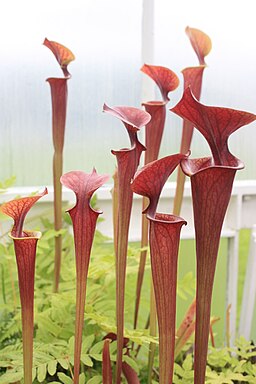Carnivorous plants are a group of plants that share the ability to capture prey, most commonly invertebrates, in order to receive nutrition. They do this as these plants typically grow in environments where the soil is poor in nutrients, especially nitrogen, such as acidic bogs and rock outcroppings, rainforests, etc. However, Carnivorous plants have been seen digesting things from monkey poop to leaves, so they are not the most picky of eaters. In order to digest food, plants may produce their own enzymes or use bacteria and other organisms for digestion. They have evolved various specialized structures, such as modified leaves, to trap and digest their prey. The adaptation of carnivory in plants involves complex morphological, physiological, and ecological features. These plants usually produce nectar, scent, or visual lures to attract prey. Once the prey is captured, the plant uses enzymes or other means to break down the prey’s body and absorb the nutrients.
Here, I listed a few examples of the diverse and fascinating world of carnivorous plants. Each type has evolved and has unique adaptations to thrive in its particular environment.
Venus Flytrap (Dionaea Muscipula)
The Venus Flytrap is one of the most iconic carnivorous plants. It is native to subtropical wetlands in the United States. The trap is made of a pair of lobes at the end of each leaf. The inner surfaces are equipped with sensitive hair that, once touched twice within 30 seconds, will close the trap. The Venus Flytrap has been extensively cultivated with several cultivars providing unique coloration shapes etc.

Pitcher Plants
(Sarraceniaceae and Nepenthaceae Families)
Pitcher plants have leaves that are modified into a pitcher shape. There are several genera, including Nepenthes, Sarracenia, and Cephalotus. The pitchers are usually filled with a liquid that the plant secretes. Insects and other small creatures are attracted to the pitcher, often by nectar or scent, where they slip and fall into the liquid and are digested.
Sarracenia
These are native to North America. The pitchers arise from a low-growing rosette and often have a hood-like structure over the opening.

Heliamphora
Known as the Sun Pitchers Heliamphora are closely related to Saccarina and live in South Americia, they are unique as they lack a lid and instead have a nectar-producing “spoon”.

Nepenthes
Nepenthes are tropical pitcher plants found in Southeast Asia. They often have large, dramatic pitchers that can capture not just insects but occasionally even small vertebrates.

Darlingtonia
Known as the Cobra pitcher, Darlingtonia is unique as does not use rainwater in its pitches. It adds its own water from its roots. It has many false exits hairs and a curled hood that makes it hard for pray to escape.

Sundews (Drosera)
Sundews are characterized by the sticky, gland-tipped tentacles on their leaves. There are over 190 species, and they can be found worldwide. When an insect touches these sticky tentacles, it gets trapped. The tentacles then slowly fold over the prey and release enzymes to digest it.

Butterworts (Pinguicula)
Butterworts have flat, sticky leaves that trap insects. They are found in Europe, North America, and Central America. Once an insect is caught, the leaf slowly wraps around the prey to digest it.

Resources:
-
- BVBurton, CC BY-SA 4.0 <https://creativecommons.org/licenses/by-sa/4.0>, via Wikimedia Commons
- Stephencdickson, CC BY-SA 4.0 <https://creativecommons.org/licenses/by-sa/4.0>, via Wikimedia Commons
- Dals093838, CC BY-SA 4.0 <https://creativecommons.org/licenses/by-sa/4.0>, via Wikimedia Commons
- NoahElhardt (talk · contribs), CC BY-SA 3.0 <http://creativecommons.org/licenses/by-sa/3.0/>, via Wikimedia Commons
- Manfred Werner – Tsui, CC BY-SA 3.0 <https://creativecommons.org/licenses/by-sa/3.0>, via Wikimedia Commons
- Robert Balog (Bergadder), CC0, via Wikimedia Commons
- Common Butterwort (Pinguicula vulgaris) by Anne Burgess, CC BY-SA 2.0 <https://creativecommons.org/licenses/by-sa/2.0>, via Wikimedia Commons
- randreu, CC BY 3.0 <https://creativecommons.org/licenses/by/3.0>, via Wikimedia Commons